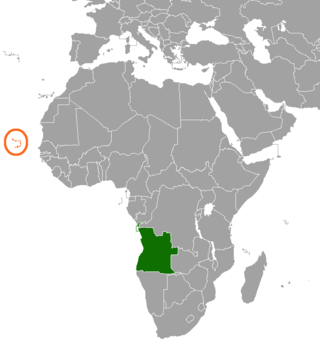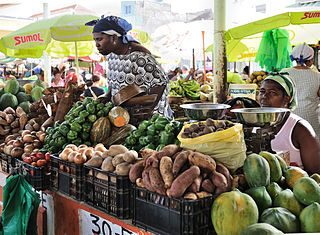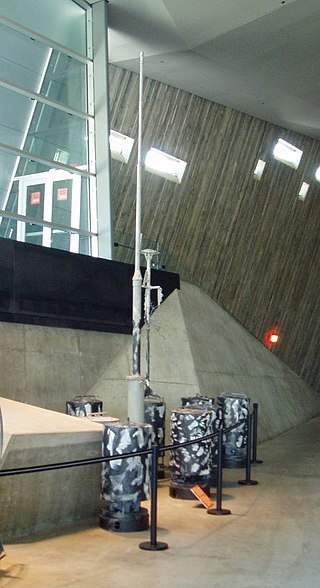Related Research Articles

The recorded history of Cape Verde begins with the Portuguese discovery of the island in 1458. Possible early references to Cape Verde date back at least 2,000 years.

Cape Verde is known internationally for morna, a form of folk music usually sung in the Cape Verdean Creole, accompanied by clarinet, violin, guitar and cavaquinho. Funaná, Coladeira, Batuque and Cabo love are other musical forms.

The North African campaign of the Second World War took place in North Africa from 10 June 1940 to 13 May 1943. It included campaigns fought in the Libyan and Egyptian deserts and in Morocco and Algeria, as well as Tunisia. The campaign was fought between the Allies and the Axis Powers. The Allied war effort was dominated by the British Commonwealth and exiles from German-occupied Europe. The United States officially entered the war in December 1941 and began direct military assistance in North Africa on 11 May 1942.
Cape Verdean Americans are an ethnic group of Americans whose ancestors were Cape Verdean. In 2010, the American Community Survey stated that there were 95,003 Americans living in the US with Cape Verdean ancestors.

Baltasar Lopes da Silva was a writer, poet and linguist from Cape Verde, who wrote in both Portuguese and Cape Verdean Creole. With Manuel Lopes and Jorge Barbosa, he was the founder of Claridade. In 1947 he published Chiquinho, considered the greatest Cape Verdean novel and O dialecto crioulo de Cabo Verde which describes different dialects of creoles of Cape Verde. He sometimes wrote under the pseudonym Osvaldo Alcântara.

At the start of World War II in 1939, the Portuguese Government announced on 1 September that the 550-year-old Anglo-Portuguese Alliance remained intact, but since the British did not seek Portuguese assistance, Portugal was free to remain neutral in the war and would do so. In an aide-mémoire of 5 September 1939, the British government confirmed the understanding. As Adolf Hitler's occupation swept across Europe, neutral Portugal became one of Europe's last escape routes. Portugal was able to maintain its neutrality until 1944, when a military agreement was signed to give the United States permission to establish a military base in Santa Maria in the Azores and thus its status changed to non-belligerent in favour of the Allies.

Jorge Vera-Cruz Barbosa was a Cape Verdean poet and writer. He collaborated in various reviews and Portuguese and Cape Verdean journals. The publication of his poetry anthology Arquipélago (Archipelago) in 1935 marked the beginning of Cape Verdean poetry. He was, along with Baltazar Lopes da Silva and Manuel Lopes, one of the three founders of the literary journal Claridade ("Clarity") in 1936, which marked the beginning of modern Cape Verdean literature.

The neutral powers were countries that remained neutral during World War II. Some of these countries had large colonies abroad or had great economic power. Spain had just been through its civil war, which ended on 1 April 1939 —a war that involved several countries that subsequently participated in World War II.

Angola and Cape Verde are members of the African Union, Community of Portuguese Language Countries, Group of 77 and the United Nations.

The economy of Cape Verde is a service-oriented economy that is focused on commerce, trade, transport and public services. Cape Verde is a small archipelagic nation that lacks resources and has experienced severe droughts. Agriculture is made difficult by lack of rain and is restricted to only four islands for most of the year. Cape Verde's economy has been steadily growing since the late 1990s, and it is now officially considered a country of average development, being only the second African country to have achieved such transition, after Botswana in 1994. Cape Verde has significant cooperation with Portugal at every level of the economy, which has led it to link its currency first to the Portuguese escudo and, in 1999, to the euro.

Cape Verde or Cabo Verde, officially the Republic of Cabo Verde, is an archipelago and island country in the central Atlantic Ocean, consisting of ten volcanic islands with a combined land area of about 4,033 square kilometres (1,557 sq mi). These islands lie between 600 and 850 kilometres west of Cap-Vert, the westernmost point of continental Africa. The Cape Verde islands form part of the Macaronesia ecoregion, along with the Azores, the Canary Islands, Madeira, and the Savage Isles.

The North Atlantic weather war occurred during World War II. The Allies and Germany tried to gain a monopoly on weather data in the North Atlantic and Arctic oceans. Meteorological intelligence was important as it affected military planning and the routing of ships and convoys. In some circumstances, visibility was necessary and in others concealment. D-day planning was greatly affected by weather forecasting; it was delayed by one day in the expectation that a storm would blow out and sea conditions would be acceptable. British sources of data included ships at sea and the weather stations at Valentia Observatory and Blacksod Point, in neutral Ireland; German use of weather ships also exposed their secret Enigma codes.

Cape Verde was a colony of the Portuguese Empire from the initial settlement of the Cape Verde Islands in 1462 until the independence of Cape Verde in 1975.

Cape Verdeans, also called Cabo Verdeans, are a creole ethnic group native to Cape Verde, an island nation in West Africa consisting of an archipelago in the central Atlantic Ocean. Cape Verde is a nearly homogeneous creole society, which means that it is home to people of many different racial origins who share a common culture and heritage. Cabo Verdeans may consider themselves to be different races, though most do not, seeing themselves as Verdean, but also share a national identity and are welcoming to African and European immigrants to their islands.
Operation Alacrity was the code name for a possible Allied seizure of Azores during World War II. It never took place because Portugal agreed to an Allied request for use of air bases. The islands were of enormous strategic value in the defeat of the German U-boats. Portugal, too weak to defend the Azores, or its large colonial empire, or even its homeland, tried to stay neutral in the war. Dictator Salazar was especially worried about a possible German invasion through Spain and did not want to provoke Hitler nor did he want to give Spain an excuse to side with the Axis and invade Portugal due to the strategic importance of the Canary Islands. Great Britain and the United States devised plans to set up air bases regardless of Portugal's disapproval. The plans were never put into operation. Instead in 1943 Britain requested, and Portugal agreed, to allow Britain to set up bases there. Operation Alacrity was preceded by War Plan Gray.
Codé di Dona, nickname of Gregório Vaz, was a Cape Verdean musician and composer.

The archipelago of Cape Verde has been struck by a series of drought-related famines between the 1580s and the 1950s. During these periods of drought and famine, tens of thousands of inhabitants died from starvation and diseases.

Operation Pilgrim was a planned British operation to invade and occupy the Canary Islands during World War II. The invasion was a contingency plan to be executed in the event of a known plan whereby Germany would support Spain in occupying Gibraltar, the Azores, the Canary Islands as well as the Cape Verde Islands. The British feared that such occupation would materially affect Allied access to the Mediterranean and endanger Britain’s shipping-lanes to its Dominions. Operation Pilgrim was a preemptive invasion and occupation to prevent German control of the islands. The German invasion never materialised and consequently, Operation Pilgrim was never put into action.
References
- ↑ "Shipwreck: Georges A. Rocha". World Wide Voluntary Observing Ship Program. Retrieved August 19, 2020.
- ↑ "694. Basic Plan for Capture and Occupation of Azores (Gray)". The National Archives Catalog. The U.S. National Archives and Records Administration. Archived from the original on 5 March 2016. Retrieved 22 November 2015.
- ↑ Lycett, Andrew (February 17, 2011). "Breaking Germany's Enigma Code". BBC History . Retrieved August 19, 2020.
- ↑ Keese, Alexander (2012). "Managing the Prospect of Famine. Cape Verdean Officials, Subsistence Emergencies, and the Change of Elite Attitudes During Portugal's Late Colonial Phase, 1939-1961" (PDF). Itinerario . XXXVI (1): 49–69. doi:10.1017/S0165115312000368.
- ↑ Brooks, George E. (2006). "Cabo Verde: Gulag of the South Atlantic: Racism, Fishing Prohibitions, and Famines". History in Africa . 33: 101–135. doi:10.1353/hia.2006.0008. hdl: 2022/3269 .
- ↑ Barboza, Ron (May 24, 2020). "Saluting living World War II Cape Verdean American veterans from the Southcoast". SouthCoastToday.com. Archived from the original on May 25, 2020. Retrieved August 19, 2020.